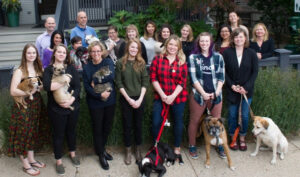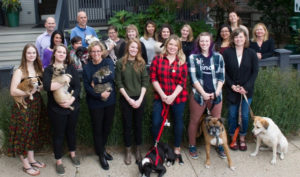In a recent focus group study presented at the January 2013 North American Veterinary Conference, veterinarians were asked if they found it challenging to diagnose medical conditions in dogs and cats. Fifty-seven percent of the veterinarians found it challenging to diagnose conditions in cats and 34 percent challenging in dogs. Now, imagine asking pet owners who have no medical training the same question. I’m confidant that the percentage of people finding it challenging to diagnose conditions in their dog or cat substantially higher. In fact, many clients do not even recognize their pet is ill or in pain. Did you know that over 80 percent of all pets over eight years of age have at least one unrecognized disease by their owners?
Why is it so difficult to recognize a sick pet? First, pets do not clearly articulate what is wrong with them. Wouldn’t it be wonderful if your cat told you the reason she is urinating in your bathroom sink is because she has a bladder infection? Second, dogs and cats hide their illnesses for instinctual purposes. In the wild, pets that are ill and display overt signs of not feeling well will likely fall victim to predators.
To highlight the difficulties of recognizing an illness in your pet I would like to present you three recent medical cases I have seen at Animal Medical Center of Chicago.
Case 1: The case of the fighting brothers.
Last week I had the pleasure of examining two beautiful Somali cats for their annual physical examination. Historically, these 2-year-old cats were loving brothers. They played, groomed and slept curled around each other every night. Recently, however, the owners had noticed that the cats were fighting more and not sleeping together. On physical examination of both cats each had severe stomatitis — which is a term reserved for severe inflammation of the gum tissue. The gums were ulcerated and cherry red in color. I informed the clients that both of their cats needed immediate dental care, which would include a dental cleaning, probing, radiography and oral surgery to remove numerous problematic teeth. The owners were shocked that they did not notice any problems. The cats were eating well and showed no obvious dental pain like drooling, difficulties chewing or facial swelling. I told the clients that pet’s can be very secretive about their pain — it is an adaptive response to living in the wild. To temporarily reduce their pets’ discomforts, I sent the clients home with pain medication and antibiotics. We scheduled oral surgery for the following week. Two days later I called the client for an update and the pets were doing great. They were playful and positively interacting with each other again. As the client reported, “They are acting like kittens again.”
Case 2: The case of the stoic shelter dog.
Approximately two weeks ago a client rescued a really sweet, probably 2-year-old pit-bull, named Pilot, from a local shelter. Pilot had been sitting in a shelter cage for almost four weeks after being abandoned on the streets. The dog walked with a slight limp on his left hind limb. When he was standing still, I noticed that he would shift almost 75 percent his weight onto his right hind limb. A pelvic radiograph revealed multiple pelvic fractures. Although it was tragic that this pet was in a shelter cage for almost a month without any medical care, this benign neglect worked to his benefit. His immobility allowed the fractures to almost heal by itself. Since the fracture was healing nicely on its own, I recommended to the owner to start anti-inflammatory and pain medications along with some nutra-pharmaceutical drugs to help with wound healing. I told her to continue to severely limit his activity and repeat pelvic radiographs in four weeks. Unfortunately (or maybe fortunately??) Pilot has an extremely high pain threshold that masked his true problems. I believe the well-intentioned shelter workers did not perceive Pilot in discomfort and therefore, did not seek appropriate medical or surgical care.
Case 3: The case of the playful Labrador retriever.
Just the other day one of my clients brought in her playful 8-year-old Labrador retriever, named Bentley, for a yearly examination. When I entered the room Bentley was jumping up and down off our examination table looking for treats. I asked the owner routine questions like, ” Is Bentley eating well? Is he having normal stools? Any signs of orthopedic discomfort, like difficulties going up and down stairs or stiffness after rising?” The owner told me that after daycare Bentley is exhausted and can barely walk. She told me that she thinks he is just tired and that’s it. During my physical examination, I discovered that Bentley was moderately painful when I palpated both hips and shoulders. I told her that her dog is most likely suffering from degenerative joint disease (arthritis) and not exhaustion. I recommended radiographs of the problematic joints. The owner had not perceived Bentley in pain or suffering from any musculoskeletal problem given her dog’s energetic personality but it was obvious from my examination that he was uncomfortable.
These three cases are perfect examples of pet’s hiding their illnesses or diseases from their owners. Every day clients bring their “apparently healthy pet” to see me for their yearly examination and I frequently discover a medical condition that the client did not recognize. It is not that my clients are not observant or loving, it is that a pet will do their best to hide a problem.
Given their secretive nature, if your pet’s behavior deviates from its normal routine, please take note of it. Maybe he/she is trying to discretely tell you something. If he/she is sluggish, seeking more or less attention, or not eating with the same gusto as it normally does, this may be your only sign that something may be awry. Please contact your veterinarian for advise.
Be observant. Be your pet’s best advocate for good health care. Don’t let your pet keep secrets!f change and get involved in your pet friendly neighborhood.


